
* Svenska Aeroplan AB (SAAB) of Sweden became well-known in the postwar period for the design of a series of excellent fighters that had long and distinguished service careers. Among the earliest of these fighters was the SAAB J 29 "Tunnan (Barrel)", a portly aircraft that was surprisingly fast and agile, and the "SAAB 32 Lansen (Lance)" attack fighter. Both provided excellent service to the Flygvapnet, the Swedish air force. This document provides a history and description of the Tunnan and Lansen.
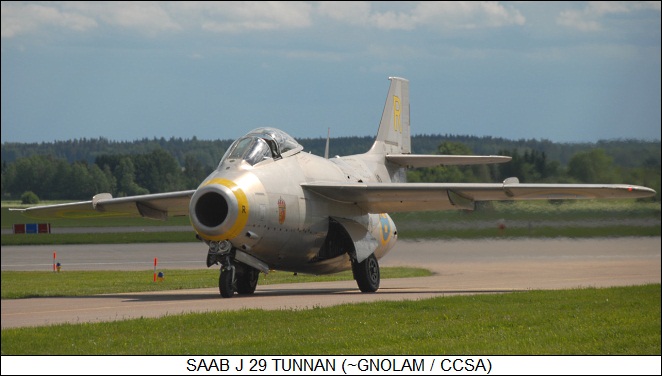
* The Swedes were thoroughly intimidated by the fall of Denmark and Norway to Hitler in the spring of 1940, since they knew their country could not withstand a German assault. The crisis led to a high-priority effort to improve Sweden's defenses, with a strong emphasis on the development of modern combat aircraft that carried into the postwar period. By the end of the conflict, it was obvious to the engineers of the primary Swedish aviation company, Svenska Aeroplan AB (SAAB), that jet power was the way of the future for combat aircraft. However, Axis and Allied jet development efforts were largely secret, and the Swedes had little knowledge of the technology.
They worked hard to catch up. By the fall of 1945, they were able to get their hands on the British de Havilland Goblin centrifugal-flow turbojet engine, quickly arranging to manufacture it under license. SAAB used the Goblin engine to provide the Flygvapnet (Swedish Air Force) with the first indigenous Swedish jet fighter by fitting the engine to the innovative J 21 pusher-prop fighter -- the "J" stood for "Jakt (Fighter)", by the way -- developed during the war. The first jet-propelled "J 21R" flew in 1947.
The J 21R was a step in the right direction, but it was still well behind the times. As an interim measure, until Swedish industry could provide up-to-date combat aircraft, the Flygvapnet obtained a quantity of British de Havilland Vampire F.1 jet fighters, giving them the designation "J 28A". The first J 28A Vampires reached operational service in 1947.
* In the meantime, SAAB was working on advanced design studies for jet fighter aircraft, beginning with the "RX-1", which was roughly along the lines of the Vampire, and then the "R-101" or "Cigar", which was more along the lines of the American Lockheed P-80 Shooting Star. SAAB engineers had no knowledge of the P-80 when they drew up the R-101 design, and when they found out about the Shooting Star, they realized they were lagging developments by several years. They went back to the drawing board.
By October 1945, a SAAB team under Lars Brising had come up with a fighter design study built around the Goblin, featuring the engine stuffed into a fuselage with a straight-in intake in the nose and a straight-out exhaust in the rear, and the pilot perched in the fuselage above the engine under a sliding bubble canopy. The laminar-flow wing was to be very thin, and so the tricycle landing gear had to retract into the fuselage. The resulting fuselage had a fat appearance. The fuselage extended above the exhaust to support the tail assembly, this configuration giving the tail adequate clearance on steep take-offs despite short landing gear.
The Flygvapnet was interested in the design, but then SAAB learned that de Havilland had developed a new centrifugal-flow turbojet named the Ghost that was substantially more powerful than the Goblin. SAAB engineers worked with their de Havilland counterparts and determined that the Ghost would fit into the new fighter design.
During a visit to Switzerland, a SAAB staffer ran across a paper on German swept-wing aerodynamic research data from the war, to bring it back to Sweden for Brising and his team to inspect. The design was then modified from the original straight wing to a wing with a sweepback of 25 degrees. The design study of the revised jet fighter concept, with the Ghost engine and swept wing, was complete by early 1946.
The new fighter was expected to have a top speed of 1,000 KPH (620 MPH), and the Flygvapnet became very keen on it. A formal development program was begun in February 1946 under the project designation of "R-1001". Wind tunnel tests were performed, and a SAAB 91A Safir light piston aircraft was fitted with a half-scale version of the 25-degree swept wing for flight tests that began in the spring of 1946. This odd experimental aircraft was designated "Aircraft 201".
* In the fall of 1946, the Flygvapnet ordered three prototypes of the fighter, which was given the designation "J 29". The initial prototype made its first flight on 1 September 1948, with test pilot Robert Moore, a Briton living in Sweden, at the controls. Moore was pleased with the machine, saying: "It was love at first flight. An ugly duckling on the ground, but in the air a swift."
The prototype was powered by a de Havilland Ghost 45 engine, with 19.6 kN (2,000 kgp / 4,400 lbf) thrust. The aircraft had power-boosted ailerons, with leading-edge slats fitted to the outer part of the wings to reduce landing speed. The slats were extended automatically when the flaps were lowered. Performance exceeded expectations, and despite the aircraft's tubby looks, the J 29 proved surprising agile. The first two prototypes were unarmed, but the third was fitted with four Bofors 20-millimeter cannon. The cannon were fitted under the nose intake and had 180 rounds per gun. A fourth prototype was also ordered, flying in 1950.
BACK_TO_TOP* The first production version of the "Flygande Tunnan (Flying Barrel)", as it was nicknamed, was the "J 29A". A total of 224 was built from 1951 to 1954, with the type initially entering Flygvapnet service in January 1952. The J 29A was powered by the RM2 Ghost turbojet with 22.3 kN (2,270 kgp / 5,000 lbf) thrust, built under license by Svenska Flygmotor. Trim tabs were added, as well as dive brakes. The dive brakes were mounted on the wings in early J 29A production, but were then moved to the fuselage ahead of the main landing gear doors.
Pilots found the aircraft pleasant to fly, though it did have a few handling quirks under certain circumstances. The Tunnan was very easy to maintain, with 145 service doors, hatches, and ports. Engine changes only took a couple of hours, even given the crudest service facilities. However, an inlet screen had to be implemented after a conscript was sucked into the engine intake and killed.
* The J 29A was followed by the "J 29B", which was fitted with extra fuel tanks in the wings, increasing its fuel capacity by 50%. It also was fitted with stores pylons for bombs and rockets, allowing it to be used in the attack role. For that reason it was also referred to as the "A 29B", where "A" of course stood for "Attack". Possible J 29B underwing loads included:
The initial flight of the J 29B was on 11 March 1953, and 332 were built from 1953 to 1955. The type set a world speed record of 977.35 KPH (607.05 MPH) over a 500-kilometer (310-mile) closed-circuit course in 1954. The Tunnan was a leading-edge fighter by the standards of the time; during a visit to the UK in 1953, a group of Swedish pilots with Tunnans got a chance to take on US Air Force F-86 Sabres, with the two types proving very equivalent in performance. The Tunnan could out-turn the Sabre, but the Sabre could out-loop the Tunnan.
* SAAB was also working on a reconnaissance variant of the Tunnan, the "S 29C", where "S" stood for "Spaning (Reconnaissance)". This version featured a modified nose, with a flat bottom and straight sides, accommodating five cameras of various sorts. The cameras replaced the four cannon. The S 29C also had tail-warning radar, originally mounted in the tailcone, but later moved to the fuselage.
Initial flight of the S 29C was on 3 June 1953. 76 were built from 1954 through 1956. While most Tunnans flew in natural metal finish, the S 29Cs generally operated at low level and so were given a disruptive camouflage pattern of dark brown and dark green on the top surfaces. Two S 29Cs set an international speed record of 900.6 KPH (559.4 MPH) over a 1,000-kilometer (621-mile) closed-circuit course in 1955.

Other work proceeding in parallel focused on improving the Tunnan's performance. Svenska Flygmotor developed an afterburning version of the Ghost turbojet, the RM2A, with 27.5 kN (2,800 kgp / 6,175 lbf) afterburning thrust, and this improved engine was fitted to a J 29B for tests. This single modified aircraft was designated "J 29D"; the modification affected its flight qualities, with this aircraft scrapped in 1961.
* In addition, SAAB engineers were refining the wing design to improve the aircraft "critical Mach number", resulting in a new wing with a "dogtooth" leading edge. The leading-edge slats were deleted, but the new wing provided good low-speed handling and the loss of the slats was not noticed. This wing was used on a new Tunnan variant, the "J 29E", with the prototype flying on 3 December 1953. 29 J 29Es were built in 1955. The new wing was also refitted to S 29C reconnaissance aircraft, with no change in designation.
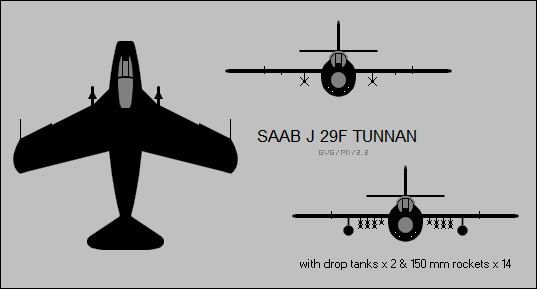
The last variant of the Tunnan was the "J 29F", which featured the afterburning Ghost engine that had been evaluated on the single J 29D and the dogtooth wing developed for the J 29E. The prototype performed its first flight on 20 March 1954, and demonstrated much improved take-off and climb characteristics.
___________________________________________________________________
SAAB J 29F TUNNAN:
___________________________________________________________________
wingspan:
11 meters (36 feet 1 inch)
wing area:
24.0 sq_meters (258.34 sq_feet)
length:
10.13 meters (33 feet 2 inches)
height:
3.75 meters (12 feet 3 inches)
empty weight:
4,845 kilograms (10,680 pounds)
max loaded weight:
8,375 kilograms (18,470 pounds)
maximum speed:
1,060 KPH (660 MPH / 575 KT)
service ceiling:
15,500 meters (50,850 feet)
range:
1,100 kilometers (680 MI / 595 NMI)
___________________________________________________________________
There were no new-production J 29Fs; all J 29Fs were updates of existing Tunnan fighter variants. The aircraft updated included the single J 29D, 288 J 29Bs, and 19 J 29Es, for a total of 308. In 1963, all J 29Fs remaining in front-line service were fitted to carry a pair of US-designed AIM-9B Sidewinder heat-seeking air-to-air missiles (AAM), built by SAAB under license as the "Robot 24" or "Rb24", the "Robot" indicating a guided missile. Fit of Sidewinders was simple since the missile seeker itself performed target locking, providing a tone to the pilot through his headphones that grew stronger in step with the target lock.
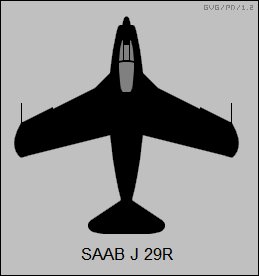
Some Tunnan variants were considered but not built. In 1950, SAAB generated concepts for the "Sk 29", where "Sk" stood for "Skol (School)", an unarmed two-seat side-by-side trainer version of the Tunnan, and also the "J 29R" single-seat radar-equipped all-weather fighter version with air-intercept radar mounted in a radome above the air intake. Since SAAB was heavily committed to production of the Tunnan fighter variants at the time, the Flygvapnet discouraged the company from pursuing these ideas, and they never happened.
BACK_TO_TOP* The Tunnan saw action in the Congo in the early 1960s as part of a United Nations (UN) peacekeeping force. Five J 29Bs were provided to the UN in the fall of 1961, followed by two S 29Cs and then four more J 29Bs. It is unclear how much action they saw, but a photo of them does survive of a number of them "beating up" an airfield with a very low-level pass, leaving UN peacekeeping troops sprawled on the runway. Four of the eleven were returned to Sweden in the spring of 1963, with the remainder being destroyed as a simple means of scrapping them.
The only foreign user of the Tunnan was Austria, which bought 15 J 29Fs in 1961. SAAB tidied them up before delivery, and the Austrians put them to use as fighter-bombers. The Austrians bought 15 more J 29Fs in 1962, with these aircraft modified by AB Svenska Flygvaerkstaederna in Malmoe to accommodate a removeable reconnaissance module. This module could be mounted on the left side of the nose, swapping out the two cannon, and twelve of these modules were delivered. The Tunnan was retired from Austrian service in 1972, being replaced by the SAAB 105. Tunnan sales deals with Israel, Finland, and Yugoslavia fell through.
The Tunnan was out of first-line service with the Flygvapnet by the mid-1960s, with a few used as target tugs and for other second-string tasks into the 1970s, with the very last in service retired in a formal ceremony in 1976. In the early 1990s, a group of Tunnan enthusiasts managed to get their hands on a J 29F that had been in storage since 1970. It still had fuel in the tanks. The aircraft, named "Gul [Yellow] Rudolf", returned to flight in 1995 and, at last notice, still puts in appearances at airshows.
* The following list gives Tunnan variants and production:
That gave total production as 665 aircraft. Some sources give the production as 661, which suggests that J 29 prototypes were brought up to J 29A status and put into operation. However, details are lacking.
* Although the Tunnan addressed the Flygvapnet's requirement for an air-superiority fighter, a need remained for an attack aircraft to deal with ground or naval targets. In December 1948, the Swedish Air Board initiated the development of a new jet-powered attack aircraft, designated the "P1150". It was to be armed with four 20-millimeter cannon. Internal rocket storage was considered, but abandoned in favor of external munitions carriage on underwing stores pylons. The aircraft was to be able to reach any target encroaching on Sweden's borders in an hour or less, and perform an effective attack in day or night, any weather. It was to be a tandem two-seat machine, with the back seat occupied by a navigator to get the aircraft to the target area.
The P1150 was originally to be powered by the Swedish-designed STAL Dovern RM4 turbojet, but that powerplant suffered development delays, and was ultimately canceled in 1954. The Rolls-Royce Avon RA.7 / Series 100, built under license by Svenska Flygmotor as the RM5, was used instead. The wing for the P1150, featuring a 35-degree sweepback, was validated by fitting the wing design to a SAAB Safir piston-engine trainer. This improvisation was designated the "SAAB 202".
Four P1150 prototypes were ordered, with the first flying on 3 November 1952. The machine looked something like a swept-wing Lockheed T-33. The type entered production the next year as the "J 32 Lansen", and broke the sound barrier on 25 October 1953 when it exceeded Mach 1 in a shallow dive.
BACK_TO_TOP* The initial production version of the Lansen was the tandem-seat "A 32A" dedicated attack variant, which entered Flygvapnet service in 1955. By 1957, twelve squadrons had been equipped with the A 32A.
The A 32A was armed with four Bofors m/49 20-millimeter cannon fitted in the nose, with 180 rounds per gun. The gun ports were sealed by shutters that popped open automatically when the pilot disengaged the weapon safety. A pair of small plates under the nose prevented the ejected casings from being sucked into the engine intakes. The casings still struck the centerline external fuel tank, and so the nose of the fuel tank was protected by a neoprene plastic shell. There were six stores pylons under each wing, for a total of twelve. Underwing stores included:
The Lansen could also carry a chaff pod to blind adversary radars. The aircraft featured a pressurized cockpit with SAAB-designed ejector seats, as well as an RM5A2 engine with a Swedish-designed afterburner. The RM5A2 provided 44.1 kN (4,500 kgp / 9,920 lbf) afterburning thrust. About a fourth of the A 32As built were fitted with a French-designed PS-431/A attack radar, built in Sweden under license. A radar-equipped Lansen would lead several other Lansens in performing attacks. Similarly, in operational practice only one aircraft of a group would carry a navigator.
The Lansen was an effective strike aircraft, providing a stable platform for cannon and rocket attacks. A total of 287 A 32As was delivered from 1955 through 1958, with that number possibly including three P1150s brought up to full production spec. The type remained in service until 1978, when it was replaced by the SAAB 37 Viggen fighter. Photographic evidence suggests that all Lansen variants were usually painted in light gray underneath and a disruptive camouflage pattern of dark green and dark brown on top.
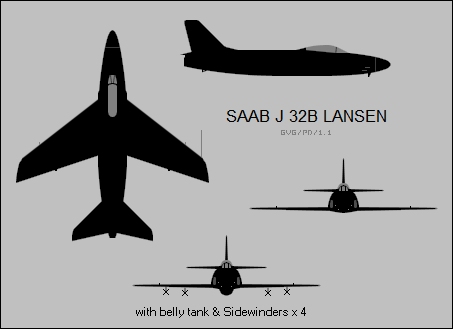
* The A 32A was followed in production by the "J 32B", a tandem-seat all-weather fighter variant. The initial J 32B first flew on 7 January 1957, and the type went into squadron service in July 1958.
The J 32B was fitted with an uprated Avon Series 200 engine, built under license as the RM6B and also featuring a Swedish-designed afterburner. The RM6B provided 67.6 kN (6,900 kgp / 15,210 lbf) afterburning thrust. The increased airflow required by the new engine led to a slight enlargement of the jet intakes. The four 20-millimeter cannon were replaced by four British Aden 30-millimeter revolver-type cannon. The gun-port shutters were deleted, and the casings were stored instead of ejected to prevent damage from strikes by spent shell casings.
___________________________________________________________________
SAAB J 32B LANSEN:
___________________________________________________________________
wingspan:
13 meters (42 feet 8 inches)
wing area:
37.4 sq_meters (402.58 sq_feet)
length:
14.7 meters (48 feet 1 inch)
height:
4.75 meters (15 feet 7 inches)
empty weight:
7,440 kilograms (16,400 pounds)
max loaded weight:
13,600 kilograms (30,000 pounds)
max speed at sea level:
1,114 KPH (692 MPH / 602 KT)
service ceiling:
15,000 meters (49,200 feet)
range with tanks:
3,220 kilometers (2,000 MI / 1,740 KT)
___________________________________________________________________
The J 32B was guided to a target by its Ericsson radar and a SAAB S6 computerized fire-control system. The pilot's control panel featured a radar gunsight display that integrated radar data with inputs from a Hughes AN/AAR-4 infrared search & track (IRST) sensor, fitted under the left wing on some J 32Bs. The radar gunsight provided indicators to tell the pilot when he had an optimum firing solution. The J 32B had four stores pylons, which were initially used to carry unguided 75-millimeter rocket pods, but from 1960 these pylons were wired to also carry the Rb-24 Sidewinder AAM. Four Sidewinders, or two Sidewinders and two rocket pods, could be carried.
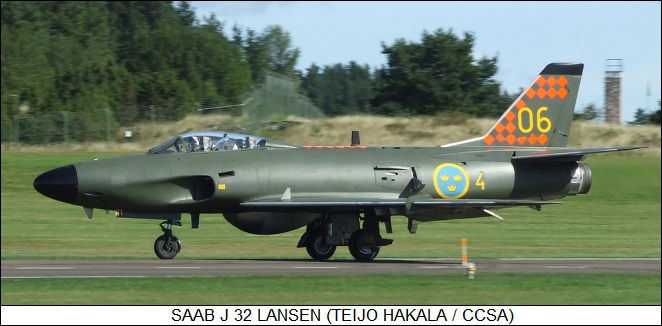
At its peak, seven Flygvapnet squadrons flew the J 32B. A total of 118 J 32Bs was delivered from 1958 through 1960. Most of the J 32Bs were withdrawn from service in the 1970s, though a few would be modified and linger for two decades longer, as explained below.
* The third and last production version of the Lansen was the "S 32C" dedicated night reconnaissance variant. The S 32C was unarmed and featured a modified nose to carry cameras, with at least two different camera suites fitted during the aircraft's operational lifetime.
The S 32C basically used the airframe of the A 32A and was powered by the A 32A's R5MA2 engine. The S 32C could carry a chaff dispenser and up to twelve British-made 75-kilogram (165-pound) photoflash bombs. It was fitted with a modified version of the A 32A's radar, designated the PS-432/A, for spotting reconnaissance targets. The radar display could be photographed to record intelligence data. The S 32C was also fitted with a radar warning receiver.
Initial flight of the S 32C was on 26 March 1957. 44 were delivered in 1958 and 1959, bringing the total of new-build Lansens to a final sum of 450; no Lansens were ever operated by any other nation. The S 32C was retired from service in 1978.
BACK_TO_TOP* A few variants of the Lansen were planned, but not built. A single-seat day fighter designated the "J 32AD" was considered in the early 1950s as a replacement for the J 29 Tunnan until the supersonic J 35 Draken entered service. The J 32AD would have no radar, and armament was to consist of four 20-millimeter cannon and one 30-millimeter cannon, along with various underwing stores. The British Hawker Hunter was obtained instead, with a total of 120 Hunters serving with the Flygvapnet under the designation of "J 34".
A true transonic version of the Lansen, the "J 32U", was also considered, with a more powerful Rolls-Royce RA-19R engine and new wings and tail, but this variant never reached the prototype stage.
* A few J 32Bs were adapted to other roles after their service as all-weather fighters. Six J 32Bs were modified beginning in 1972 as target tugs, and were given the designation "J 32D". Three J 32Bs were fitted with dual controls and used as trainers, as well as for atmospheric fallout sampling, carrying three underwing fallout sample pods storing paper filters that could be pulled out and analyzed.
A total of 15 J 32Bs was modified starting in 1972 for the electronics countermeasures / electronic warfare (ECM / EW) role, and were given the designation "J 32E". The J 32Es included a radar jammer and a signal-homing unit, and could carry chaff dispenser pods and radar or communications jammer pods. The J 32Es were used both for operational ECM / EW missions and as training platforms.
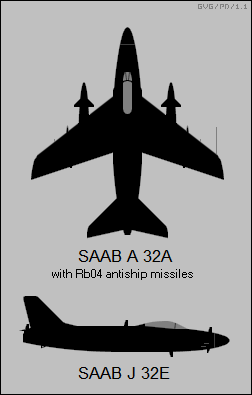
The J 32E served until 1997, when the type was finally withdrawn as a cost-cutting measure. This measure left the Flygvapnet with no ECM / EW capability for several years, but that gap was plugged by Viggens fitted with ECM / EW pods. Lansens lingered for some years after that as test and trials aircraft, with a handful also ended up in various museums.
* The following list summarizes Lansen variants and production:
That gave total production of 450 Lansens.
BACK_TO_TOP* Sources include:
A few comments from Urban Frederiksson's website were used as well.
* This document originally described just the J 29 Tunnan, with a separate document describing the J 32 Lansen. I finally decided that it made no sense to have two short documents and merged the Lansen document into this one, giving the merged document a v2.0.0 revcode. The Lansen document actually predated the Tunnan document, with an initial release date of 1 January 2001.
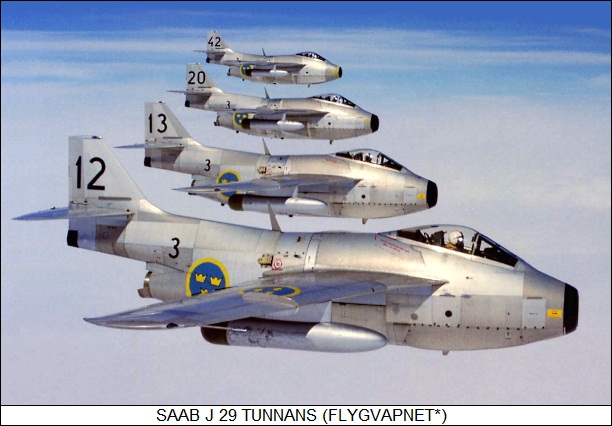
* Revision history:
v1.0 / 01 may 01 v1.0.1 / 01 may 02 / Review & polish. v1.0.2 / 01 jun 04 / Review & polish. v1.0.3 / 01 feb 06 / Review & polish. v1.0.4 / 01 jun 06 / Review & polish. v1.0.5 / 01 aug 06 / Minor corrections. v1.0.6 / 01 aug 08 / Review & polish. v1.0.7 / 01 jul 10 / Review & polish. v1.0.8 / 01 jul 11 / Review & polish. v2.0.0 / 01 may 12 / Merged in J 32 Lansen. v2.0.1 / 01 apr 14 / Review & polish. v2.0.2 / 01 mar 16 / Review & polish. v2.0.3 / 01 feb 18 / Review & polish. v2.0.4 / 01 dec 19 / Review & polish. v2.0.5 / 01 oct 21 / Review & polish. v2.0.6 / 01 sep 23 / Review & polish.BACK_TO_TOP
